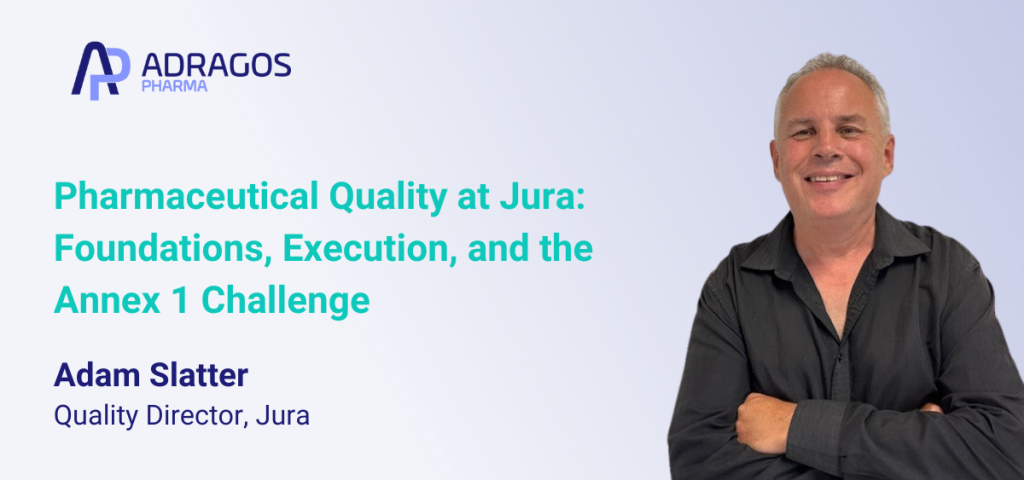At Adragos Jura, ensuring pharmaceutical quality is central to our mission of delivering medicines that are safe, effective, and consistently reliable. Even minor lapses could impact product quality and efficacy, which is why authorities such as Swissmedic, FDA, and EMA impose rigorous standards. If we are to meet these expectations across development, manufacturing and release, we must maintain strong quality principles, be fully aware of the challenges facing the industry. An unwavering focus on continual improvement is also essential.
Quality for pharmaceuticals is defined by a product’s ability to meet its intended specifications every time. This safeguards sterility, safety, efficacy, and purity. At Jura, we embed this through several foundational concepts. Careful process design integrates quality into our products from the outset, as it gives us a deep understanding of our processes, and helps us manage variability.
Good Manufacturing Practice keeps operations controlled, monitored, and compliant, leading to consistent outcomes. Risk management applies structured lifecycle assessments to identify and mitigate threats to quality and sterility. Continuous improvement uses data, feedback, and performance indicators to refine systems. Data integrity underpins all of these functions – records must remain accurate, complete, attributable, and trustworthy throughout development, production, and testing.
Jura’s effective Pharmaceutical Quality Management System translates these principles into daily practice. Drawing on ICH Q10, we set clear quality policies and measurable objectives aligned to regulatory obligations and business priorities. We define roles, responsibilities, and accountability. This means every quality-affecting activity has real ownership.
Documentation remains current and accessible, governing procedures, specifications, and records. Deviations, changes, and corrective and preventive actions are managed through robust processes designed to prevent recurrence and reduce risk. Supplier and outsourced partner oversight includes qualification, performance monitoring, and routine review. Regular internal and customer audits verify the site’s compliance, and provide opportunities for improvement. Ongoing training ensures our personnel are competent in quality-critical tasks and understand not just the “what” but the “why” behind our standards.
The revised EU GMP Annex 1 significantly elevates expectations for sterile manufacturing. It has practical implications for the technology, facilities and workforce at Adragos Jura. The document strongly favors closed systems and automation in Grade A environments to reduce human intervention and contamination risk. This includes isolators, RABS, automated handling, and even gloveless concepts. It mandates a comprehensive, scientifically justified Contamination Control Strategy, with documented rationale, validation, and data-driven oversight of every control measure. Risk management must be end-to-end, with clear, traceable documentation of how potential contamination sources are identified, evaluated, and controlled.
Environmental monitoring receives expanded emphasis, with microbial control placed alongside continuous or frequent particle monitoring. Programs need to be responsive, verify cleaning effectiveness, and trend data to identify patterns or emerging resistance. Personnel competency has become even more critical, with heightened expectations for qualification, aseptic behavior, minimized interventions, and the ability to detect critical defects. This is supported by ongoing training.
Facilities and equipment are designed to maintain Grade A continuity, optimize cleanroom layouts, and enable secure material transfers such as through pass-boxes. Bio-decontamination systems should be integrated, where appropriate. Data integrity remains non-negotiable; validated systems ensure accuracy, completeness and traceability for all information used in contamination control and batch release decisions.
At Adragos Jura, complying with these requirements has led to a significant investment in technology, facility upgrades, and process redesign. Careful planning was essential to meet timelines, maintain compliance, and avoid production interruptions or potential stock-outs. The updated Annex 1 also aligns closely with PIC/S guidance, supporting a consistent approach to products intended for global markets.
Quality management at Jura is more than a compliance exercise; it underpins patient safety and customer confidence. By embedding careful process design, robust cGMP, disciplined risk management, and a culture of continuous improvement, Adragos Jura aims to deliver high-quality medicines consistently. The new Annex 1 accelerates this commitment by emphasizing barrier technologies, comprehensive contamination control, and rigorous data integrity. With targeted investments in people, processes, and digital capabilities, our organization will meet heightened expectations, safeguard patient health, and reinforce confidence in every batch released.

